Leadership and Cultural Adaptation: Samira Tanaka Case Study Analysis
VerifiedAdded on 2022/10/18
|6
|946
|12
Case Study
AI Summary
This case study examines Samira Tanaka, a student leader, and her internship at a Japanese automotive company. The analysis highlights the differences between North American and Japanese work styles, including aspects like work hours, language use, diversity, and decision-making processes. The case explores the company's blend of Japanese and North American cultures, emphasizing its adaptations to diversity policies. Samira's leadership skills are evaluated, identifying both strengths and weaknesses in areas such as team integration, ethical leadership, and communication. The study concludes with recommendations for Samira, focusing on adapting to the diverse work environment, improving leadership skills, and fostering better relationships with colleagues. The assignment uses supporting literature to strengthen the analysis and understanding of the case study.
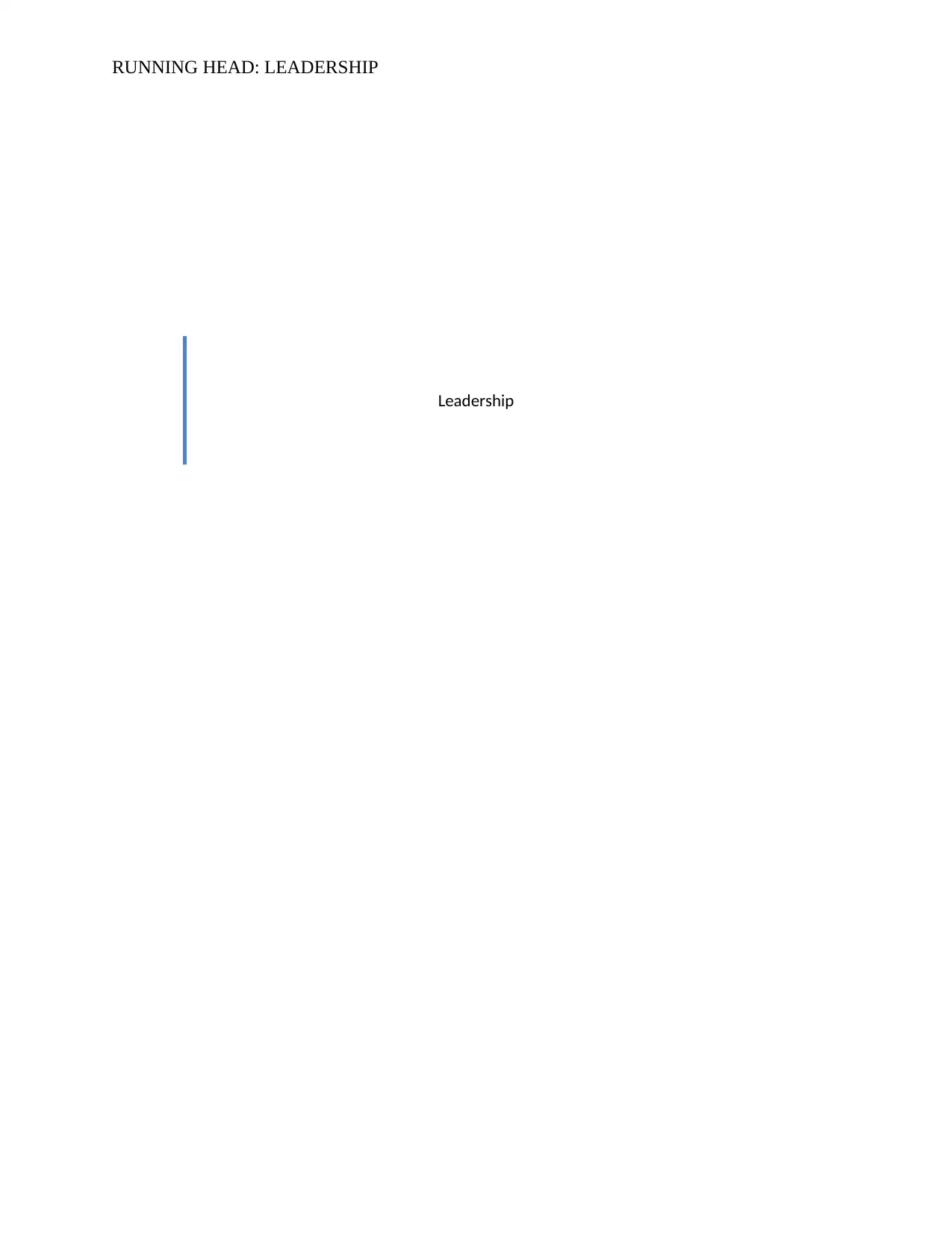
RUNNING HEAD: LEADERSHIP
Leadership
Leadership
Paraphrase This Document
Need a fresh take? Get an instant paraphrase of this document with our AI Paraphraser

LEADERSHIP 1
Contents
Bibliography....................................................................................................................................4
Contents
Bibliography....................................................................................................................................4
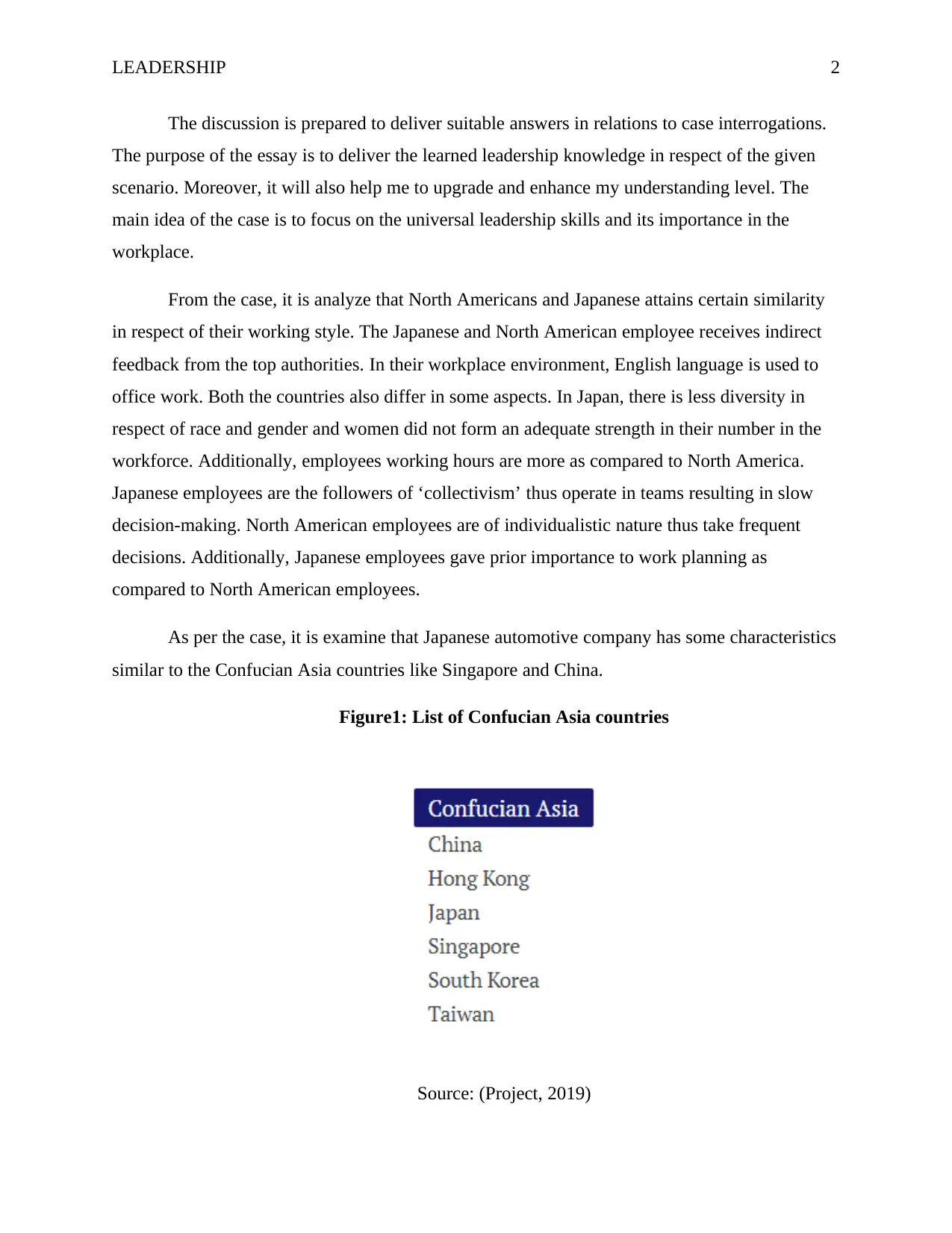
LEADERSHIP 2
The discussion is prepared to deliver suitable answers in relations to case interrogations.
The purpose of the essay is to deliver the learned leadership knowledge in respect of the given
scenario. Moreover, it will also help me to upgrade and enhance my understanding level. The
main idea of the case is to focus on the universal leadership skills and its importance in the
workplace.
From the case, it is analyze that North Americans and Japanese attains certain similarity
in respect of their working style. The Japanese and North American employee receives indirect
feedback from the top authorities. In their workplace environment, English language is used to
office work. Both the countries also differ in some aspects. In Japan, there is less diversity in
respect of race and gender and women did not form an adequate strength in their number in the
workforce. Additionally, employees working hours are more as compared to North America.
Japanese employees are the followers of ‘collectivism’ thus operate in teams resulting in slow
decision-making. North American employees are of individualistic nature thus take frequent
decisions. Additionally, Japanese employees gave prior importance to work planning as
compared to North American employees.
As per the case, it is examine that Japanese automotive company has some characteristics
similar to the Confucian Asia countries like Singapore and China.
Figure1: List of Confucian Asia countries
Source: (Project, 2019)
The discussion is prepared to deliver suitable answers in relations to case interrogations.
The purpose of the essay is to deliver the learned leadership knowledge in respect of the given
scenario. Moreover, it will also help me to upgrade and enhance my understanding level. The
main idea of the case is to focus on the universal leadership skills and its importance in the
workplace.
From the case, it is analyze that North Americans and Japanese attains certain similarity
in respect of their working style. The Japanese and North American employee receives indirect
feedback from the top authorities. In their workplace environment, English language is used to
office work. Both the countries also differ in some aspects. In Japan, there is less diversity in
respect of race and gender and women did not form an adequate strength in their number in the
workforce. Additionally, employees working hours are more as compared to North America.
Japanese employees are the followers of ‘collectivism’ thus operate in teams resulting in slow
decision-making. North American employees are of individualistic nature thus take frequent
decisions. Additionally, Japanese employees gave prior importance to work planning as
compared to North American employees.
As per the case, it is examine that Japanese automotive company has some characteristics
similar to the Confucian Asia countries like Singapore and China.
Figure1: List of Confucian Asia countries
Source: (Project, 2019)
⊘ This is a preview!⊘
Do you want full access?
Subscribe today to unlock all pages.

Trusted by 1+ million students worldwide
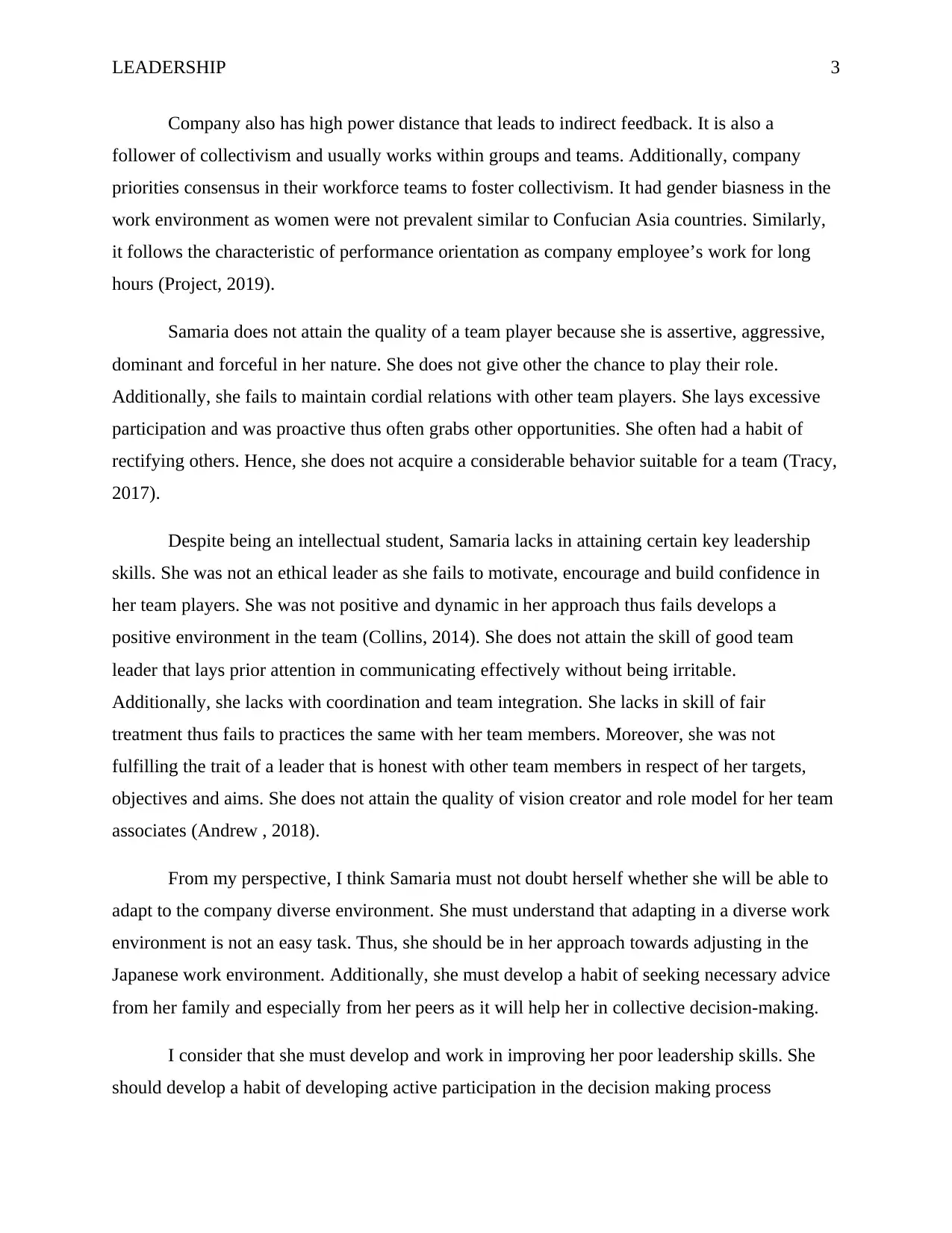
LEADERSHIP 3
Company also has high power distance that leads to indirect feedback. It is also a
follower of collectivism and usually works within groups and teams. Additionally, company
priorities consensus in their workforce teams to foster collectivism. It had gender biasness in the
work environment as women were not prevalent similar to Confucian Asia countries. Similarly,
it follows the characteristic of performance orientation as company employee’s work for long
hours (Project, 2019).
Samaria does not attain the quality of a team player because she is assertive, aggressive,
dominant and forceful in her nature. She does not give other the chance to play their role.
Additionally, she fails to maintain cordial relations with other team players. She lays excessive
participation and was proactive thus often grabs other opportunities. She often had a habit of
rectifying others. Hence, she does not acquire a considerable behavior suitable for a team (Tracy,
2017).
Despite being an intellectual student, Samaria lacks in attaining certain key leadership
skills. She was not an ethical leader as she fails to motivate, encourage and build confidence in
her team players. She was not positive and dynamic in her approach thus fails develops a
positive environment in the team (Collins, 2014). She does not attain the skill of good team
leader that lays prior attention in communicating effectively without being irritable.
Additionally, she lacks with coordination and team integration. She lacks in skill of fair
treatment thus fails to practices the same with her team members. Moreover, she was not
fulfilling the trait of a leader that is honest with other team members in respect of her targets,
objectives and aims. She does not attain the quality of vision creator and role model for her team
associates (Andrew , 2018).
From my perspective, I think Samaria must not doubt herself whether she will be able to
adapt to the company diverse environment. She must understand that adapting in a diverse work
environment is not an easy task. Thus, she should be in her approach towards adjusting in the
Japanese work environment. Additionally, she must develop a habit of seeking necessary advice
from her family and especially from her peers as it will help her in collective decision-making.
I consider that she must develop and work in improving her poor leadership skills. She
should develop a habit of developing active participation in the decision making process
Company also has high power distance that leads to indirect feedback. It is also a
follower of collectivism and usually works within groups and teams. Additionally, company
priorities consensus in their workforce teams to foster collectivism. It had gender biasness in the
work environment as women were not prevalent similar to Confucian Asia countries. Similarly,
it follows the characteristic of performance orientation as company employee’s work for long
hours (Project, 2019).
Samaria does not attain the quality of a team player because she is assertive, aggressive,
dominant and forceful in her nature. She does not give other the chance to play their role.
Additionally, she fails to maintain cordial relations with other team players. She lays excessive
participation and was proactive thus often grabs other opportunities. She often had a habit of
rectifying others. Hence, she does not acquire a considerable behavior suitable for a team (Tracy,
2017).
Despite being an intellectual student, Samaria lacks in attaining certain key leadership
skills. She was not an ethical leader as she fails to motivate, encourage and build confidence in
her team players. She was not positive and dynamic in her approach thus fails develops a
positive environment in the team (Collins, 2014). She does not attain the skill of good team
leader that lays prior attention in communicating effectively without being irritable.
Additionally, she lacks with coordination and team integration. She lacks in skill of fair
treatment thus fails to practices the same with her team members. Moreover, she was not
fulfilling the trait of a leader that is honest with other team members in respect of her targets,
objectives and aims. She does not attain the quality of vision creator and role model for her team
associates (Andrew , 2018).
From my perspective, I think Samaria must not doubt herself whether she will be able to
adapt to the company diverse environment. She must understand that adapting in a diverse work
environment is not an easy task. Thus, she should be in her approach towards adjusting in the
Japanese work environment. Additionally, she must develop a habit of seeking necessary advice
from her family and especially from her peers as it will help her in collective decision-making.
I consider that she must develop and work in improving her poor leadership skills. She
should develop a habit of developing active participation in the decision making process
Paraphrase This Document
Need a fresh take? Get an instant paraphrase of this document with our AI Paraphraser
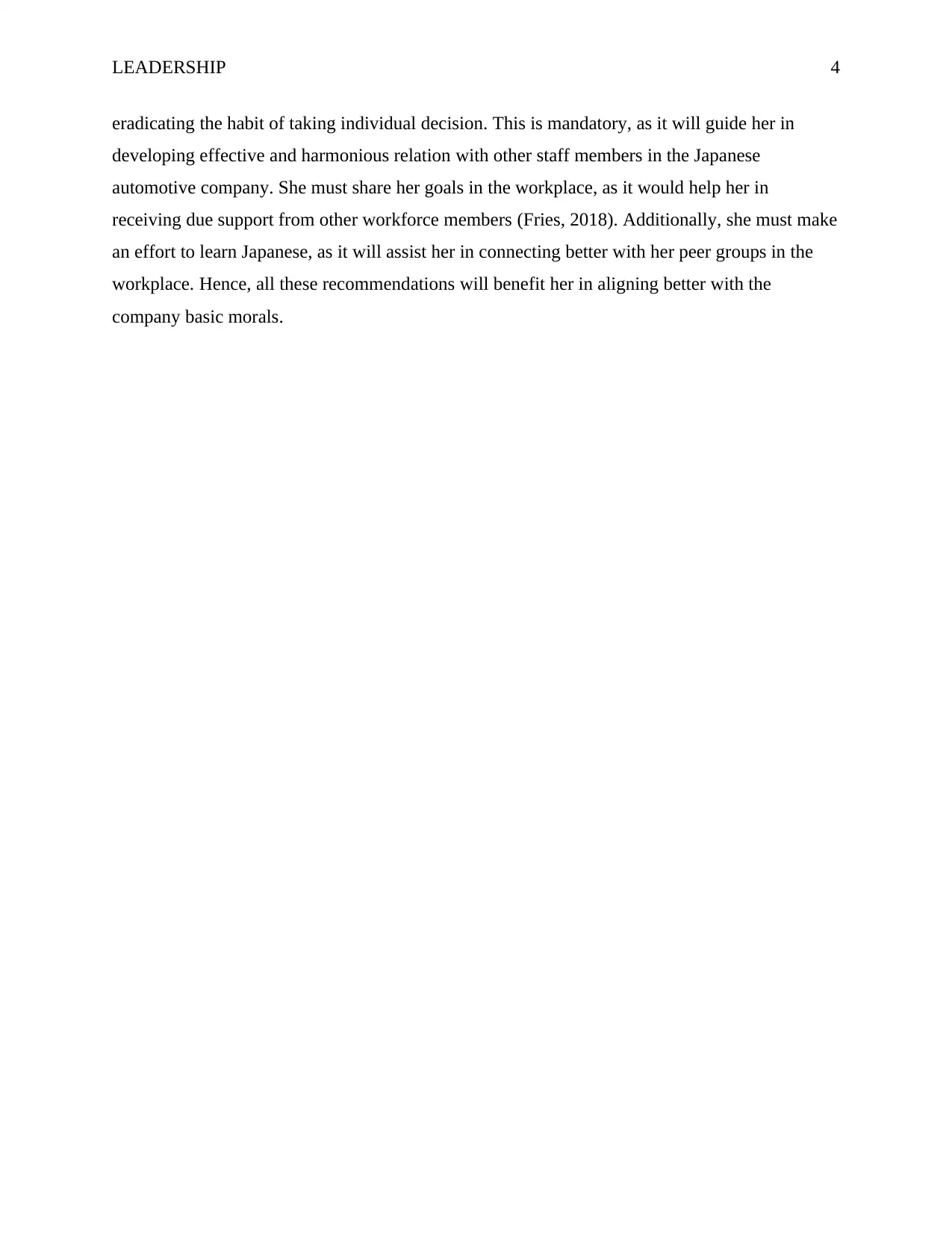
LEADERSHIP 4
eradicating the habit of taking individual decision. This is mandatory, as it will guide her in
developing effective and harmonious relation with other staff members in the Japanese
automotive company. She must share her goals in the workplace, as it would help her in
receiving due support from other workforce members (Fries, 2018). Additionally, she must make
an effort to learn Japanese, as it will assist her in connecting better with her peer groups in the
workplace. Hence, all these recommendations will benefit her in aligning better with the
company basic morals.
eradicating the habit of taking individual decision. This is mandatory, as it will guide her in
developing effective and harmonious relation with other staff members in the Japanese
automotive company. She must share her goals in the workplace, as it would help her in
receiving due support from other workforce members (Fries, 2018). Additionally, she must make
an effort to learn Japanese, as it will assist her in connecting better with her peer groups in the
workplace. Hence, all these recommendations will benefit her in aligning better with the
company basic morals.
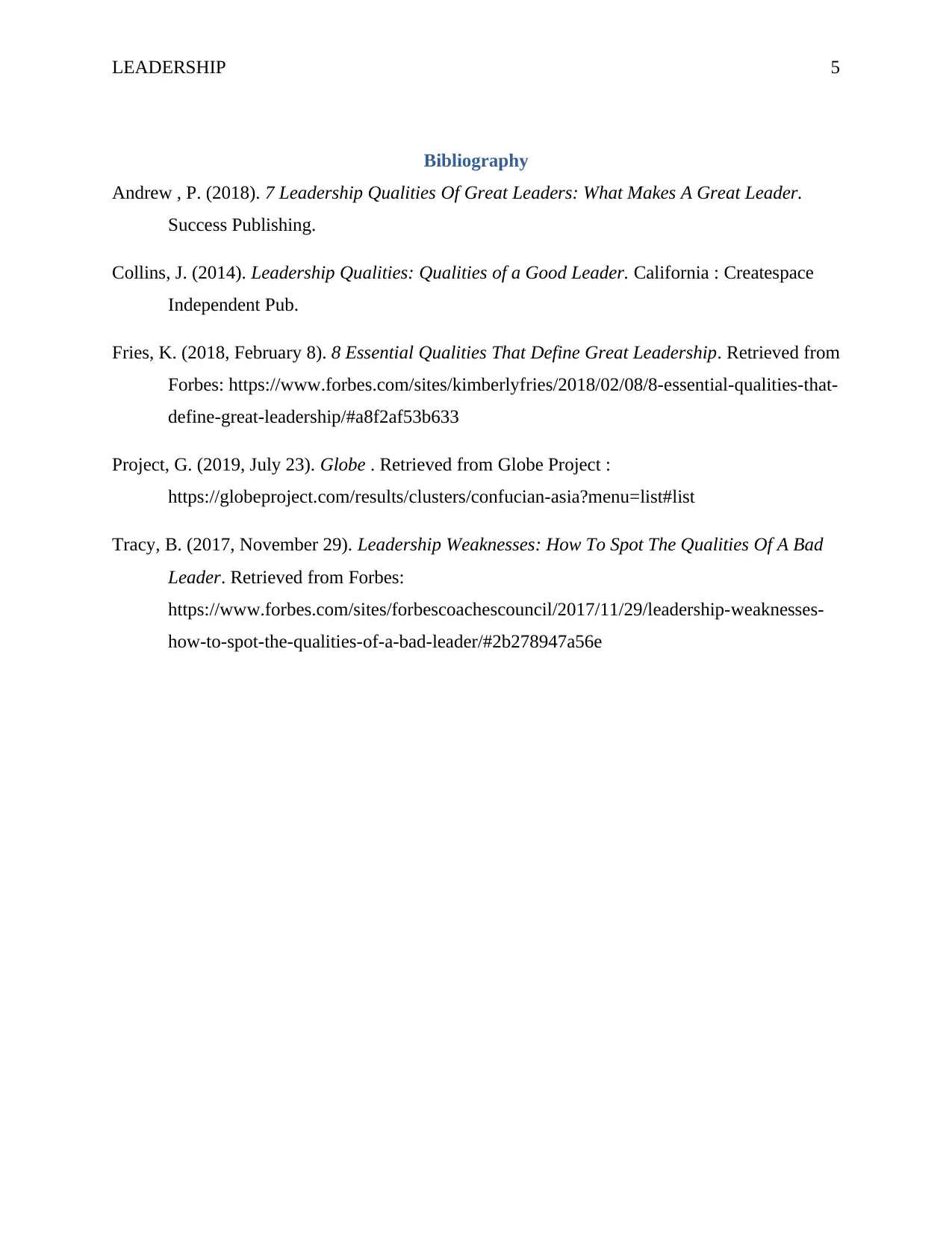
LEADERSHIP 5
Bibliography
Andrew , P. (2018). 7 Leadership Qualities Of Great Leaders: What Makes A Great Leader.
Success Publishing.
Collins, J. (2014). Leadership Qualities: Qualities of a Good Leader. California : Createspace
Independent Pub.
Fries, K. (2018, February 8). 8 Essential Qualities That Define Great Leadership. Retrieved from
Forbes: https://www.forbes.com/sites/kimberlyfries/2018/02/08/8-essential-qualities-that-
define-great-leadership/#a8f2af53b633
Project, G. (2019, July 23). Globe . Retrieved from Globe Project :
https://globeproject.com/results/clusters/confucian-asia?menu=list#list
Tracy, B. (2017, November 29). Leadership Weaknesses: How To Spot The Qualities Of A Bad
Leader. Retrieved from Forbes:
https://www.forbes.com/sites/forbescoachescouncil/2017/11/29/leadership-weaknesses-
how-to-spot-the-qualities-of-a-bad-leader/#2b278947a56e
Bibliography
Andrew , P. (2018). 7 Leadership Qualities Of Great Leaders: What Makes A Great Leader.
Success Publishing.
Collins, J. (2014). Leadership Qualities: Qualities of a Good Leader. California : Createspace
Independent Pub.
Fries, K. (2018, February 8). 8 Essential Qualities That Define Great Leadership. Retrieved from
Forbes: https://www.forbes.com/sites/kimberlyfries/2018/02/08/8-essential-qualities-that-
define-great-leadership/#a8f2af53b633
Project, G. (2019, July 23). Globe . Retrieved from Globe Project :
https://globeproject.com/results/clusters/confucian-asia?menu=list#list
Tracy, B. (2017, November 29). Leadership Weaknesses: How To Spot The Qualities Of A Bad
Leader. Retrieved from Forbes:
https://www.forbes.com/sites/forbescoachescouncil/2017/11/29/leadership-weaknesses-
how-to-spot-the-qualities-of-a-bad-leader/#2b278947a56e
⊘ This is a preview!⊘
Do you want full access?
Subscribe today to unlock all pages.

Trusted by 1+ million students worldwide
1 out of 6
Your All-in-One AI-Powered Toolkit for Academic Success.
+13062052269
info@desklib.com
Available 24*7 on WhatsApp / Email
![[object Object]](/_next/static/media/star-bottom.7253800d.svg)
Unlock your academic potential
Copyright © 2020–2025 A2Z Services. All Rights Reserved. Developed and managed by ZUCOL.


